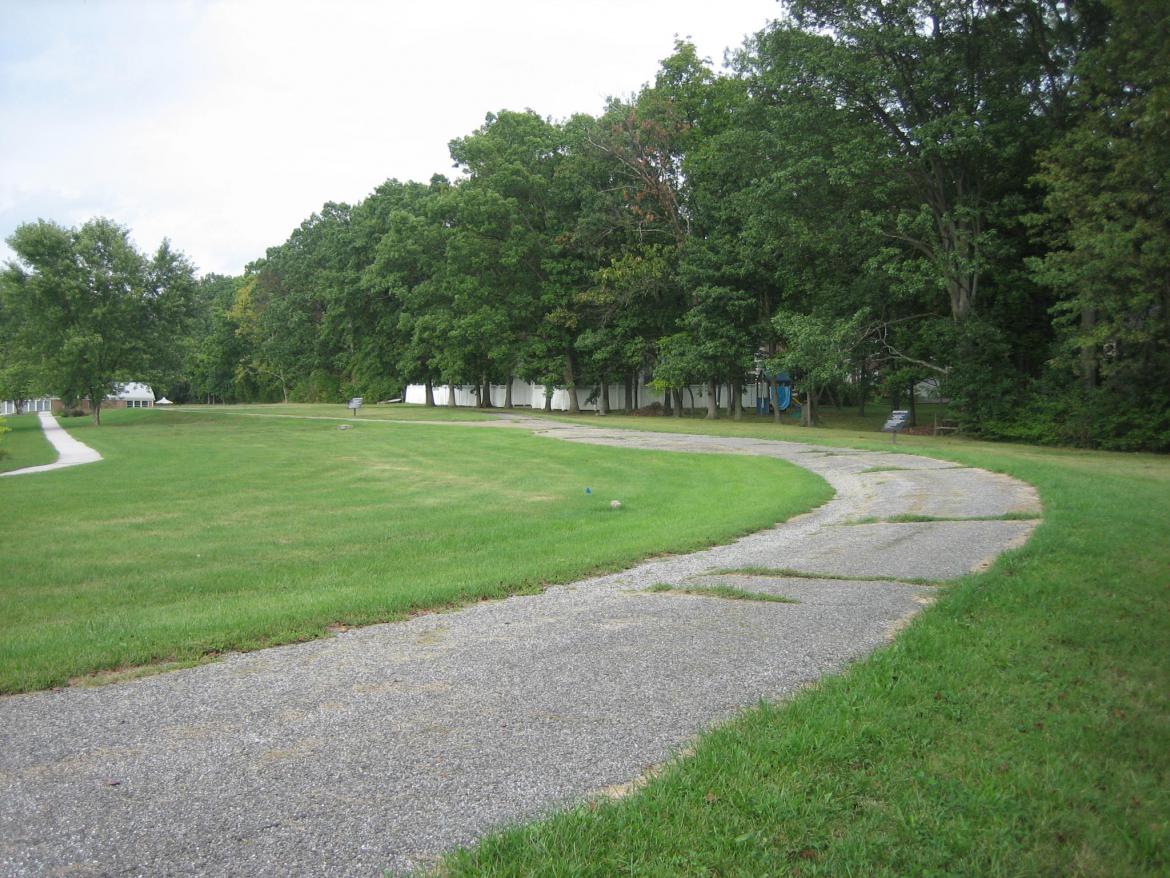Jones’ Battalion Avenue is located northeast of Gettysburg, and east of the Old Harrisburg Road. Shown on the right side of this picture, it is one of the least frequently visited areas of Gettysburg National Military Park. This view was taken from the west facing east at approximately 5:00 PM on Tuesday, September 9, 2008.
The avenue east of the Old Harrisburg Road, that marks the area occupied by Lieutenant-Colonel H.P. Jones’ Confederate artillery battalion, is seldom visited at Gettysburg. Jones’ Battalion engaged U.S. infantry and artillery forces of the Eleventh Corps. Jones report of the battle of Gettysburg stated that his unit had “three guns temporarily disabled by having shots wedged in the bores.” One Napoleon was permanently disabled.
Many visitors do not notice Jones’ Battalion Avenue because they are distracted by the Gettysburg Area High School on the west side of the Old Harrisburg Road. This view was taken from the southeast facing northwest at approximately 5:00 PM on Tuesday, September 9, 2008.
Jones’ Battalion was a Confederate Artillery Battalion in the Second Corps. This unit engaged U.S. batteries from the Eleventh Corps on this high ground on July 1, 1863. This view was taken from the west facing east at approximately 5:00 PM on Tuesday, September 9, 2008.
Jones’ Battalion was commanded by Lieutenant-Colonel Hilary Pollard Jones. Jones’ Battalion consisted of four batteries: Carrington’s, Tanner’s, Green’s and Garber’s. This view was taken from the west facing east at approximately 5:00 PM on Tuesday, September 9, 2008.
Jones’ Avenue continues to the east. By the way, Jones’ son, Hilary Pollard Jones’ Jr. was born four months after Gettysburg, in November, 1863. He attended the United States Naval Academy and graduated in 1884. In the 1920s, H.P. Jones Jr. served as Commander-in-Chief of the United States Fleet. H.P. Jones Jr. retired from the Navy in 1927, and died in 1938. This view was taken from the west facing east at approximately 5:00 PM on Tuesday, September 9, 2008.
Jones’ Avenue is squeezed in between two developments: The Gettysburg Lutheran Retirement Village to the north… This view was taken from the southwest facing northeast at approximately 5:00 PM on Tuesday, September 9, 2008.
… and the Twin Oaks subdivision to the south. This view was taken from the northwest facing southeast at approximately 5:00 PM on Tuesday, September 9, 2008.
The marker on the first small ridge is to the Charlottesville (Virginia) Artillery, commanded by Captain James McDowell Carrington. While the other three batteries of the battalion were engaged in this area against the Union’s Eleventh Corps, and Lieutenant Bayard Wilkeson’s Battery G, 4th U.S. Artillery on Barlow’s Knoll, Carrington’s was not engaged. See our post on Karlton Smith’s Ranger Program at Barlow’s Knoll on July 1, 2008. This view was taken from the south facing north at approximately 5:00 PM on Tuesday, September 9, 2008.
Jones’ Avenue then flattens out, and actually goes downhill a little as it continues to the east. The path on the left is an exercise path for the Lutheran Retirement Village. This view was taken from the west facing east at approximately 5:00 PM on Tuesday, September 9, 2008.
At the top of the hill, Jones’ Battalion Avenue will turn to the left or northeast. On this hill, twelve guns from three batteries were placed to fire at the Eleventh Corps infantry and artillery. This view was taken from the west facing east at approximately 5:00 PM on Tuesday, September 9, 2008.
The road could not continue to the east because of the Twin Oaks Subdivision. This view was taken from the southwest facing northeast at approximately 5:00 PM on Tuesday, September 9, 2008.
Plaques to Green’s, Garber’s, and Tanner’s batteries are located in this area. This view was taken from the southwest facing northeast at approximately 5:00 PM on Tuesday, September 9, 2008.
There is a pull off area on the left. The avenue turns around in the distance. This view was taken from the southwest facing northeast at approximately 5:00 PM on Tuesday, September 9, 2008.
The first plaque on the right is to Captain A. W. Garber’s (Staunton) Virginia Artillery Battery. One man was wounded in this unit at Gettysburg, Corporal Talbot B. Coleman. One of its Napoleons was struck in the muzzle by an enemy shell and “bent by a solid shot” according to H.P. Jones’ report. This view was taken from the west facing east at approximately 5:00 PM on Tuesday, September 9, 2008.
In the center of this “cul de sac” area were two artillery pieces on display. They were removed quite a while ago. This view was taken from the southwest facing northeast at approximately 5:00 PM on Tuesday, September 9, 2008.
This was the position of Captain W. A. Tanner’s Battery of the Courtney (Virginia) Artillery. An original member of this unit, First Lieutenant, later Major Joseph W. Latimer was killed on Benner’s Hill on July 2, 1863 while commanding his own artillery battalion. This view was taken from the southwest facing northeast at approximately 5:00 PM on Tuesday, September 9, 2008.
Farther to the north used to be two other artillery pieces on display, and a plaque to Captain C.A. Green’s Louisiana Guard Artillery. This view was taken from the south facing north at approximately 5:00 PM on Tuesday, September 9, 2008.
Green reported that “Early in the action, one of the Parrott guns was disabled by a shot too large lodging half way down the bore, which we found impossible to force home, and had to retire the piece.” In this position, Private Louis Tebault was killed, and two horses were disabled. This view was taken from the east facing west at approximately 5:00 PM on Tuesday, September 9, 2008.


















